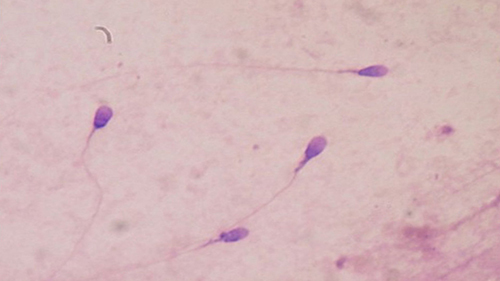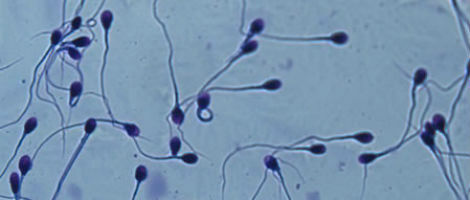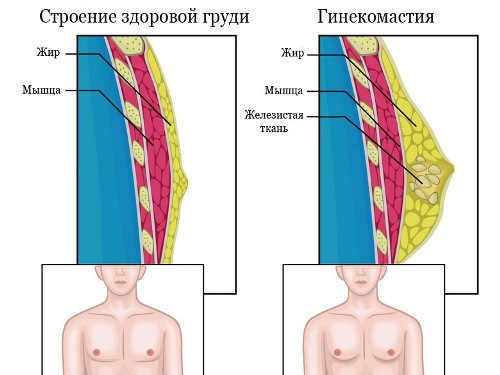The feeling of incomplete emptying of the bladder: what you need to know?
Incomplete bladder emptying is a pathological condition in which urine for one reason or another is not completely evacuated from the body. This pathognomonic sign of a variety of diseases. However, two variants of the pathogenic process should be distinguished:
- In the first case, it is a true incomplete emptying of the organ. This situation is associated with the impossibility of urine output from the urinary tract.
- In the second case, we have to talk about a false state, in which the bubble is empty, and the feeling of incomplete urine output is subjective.
The true form of pathology is more common in men. What you need to know about emptying the bladder?
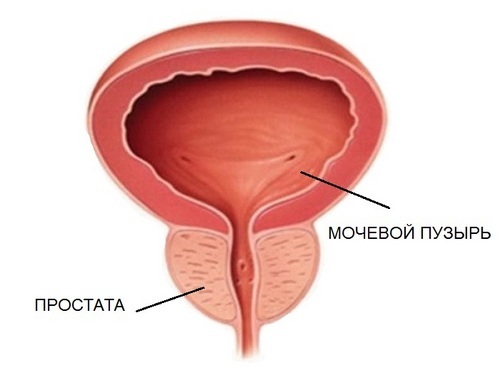
The bladder has three holes: two holes form the ureteral entry and one is the exit to the urethra.
Contents
- 1 Probable causes of the
- 2 pathology Concomitant symptomatology
- 3 Diagnostic measures
- 4 Therapy
- 5 Complications
Probable causes of the pathology
Impossibility of normal evacuation of urine is an alarming sign. He always points out a particular disease. Among the possible causes:
- Benign prostatic hyperplasia ( for more details click here).The most common cause of incomplete emptying of the bladder in men for 40. As a result of the pathogenic process, prostate tissues expand and overlap the urinary tract. It occurs similar in the late stages of adenoma formation. This situation is fraught with acute urinary retention and requires immediate medical attention.
- Prostatitis ( more details here).The insidious murderer of male sexual health. Disrupts the normal retreat of urine as a result of all the same growth of tissues. However, in this case, the process does not involve the formation of neoplasms. Prostate is enlarged in volume and obstruction and compression of urinary tracts occurs.
- Hypo-atony .Inadequate contractility of the bladder. As a result, urine does not come out in full.
- Sexually Transmitted Infections .First of all - genital herpes.
- Occlusion of urinary structures by calcifications of .It often causes an acute delay in urine, but it is also possible that the hollow organ is not fully emptied.
- Structures of the urethra ( more details here).
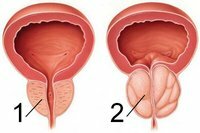
Prostate:
1 - OK;2 - prostatitis
If it is a false sensation, the reasons may be different:
- Cystitis ( more).Cystitis. Irritated walls convey false signals about overcrowding of the body.
- Urethritis .Inflammation of the urethra.
- Prostatitis and prostate adenoma can also cause a false sensation of the full bladder due to pressure on the body walls.
- Psychogenic causes of .
Concomitant symptomatology
Often incomplete emptying of the bladder is accompanied by a mass of symptoms:
- Pain syndrome .It is localized in the area of the pubis, penis, loin, anus. There is a moderate intensity of pain, by nature they are aching, pulling. Increase when you visit the toilet room, the commission of sexual intercourse.
- Sensation of bubble overflow of .Especially when it comes to true incomplete emptying.
- Disorders of the process of urination .The jet becomes sluggish, as the pressure of urine drops. The process is accompanied by severe pains or completely abruptly cut off at the peak of the process.
- Disorders of erection .The erection also suffers. The penis becomes insufficiently hard to perform a normal sexual intercourse. And nocturnal erection disappears. The reason is purely physiological.
- In the late stages of the development of the true form of the disease, symptoms of urinary incontinence occur.
- An imperative urge to urinate , which does not end with success: urine does not go away at all or is excreted in small drops.
Diagnostic measures
The main task of diagnostics is to determine whether the incomplete emptying of the bladder is true or false. Only then does the root cause of the condition come to light. For examination, you need to contact a doctor-urologist.
In the initial consultation, the patient's task is to tell the specialist about his complaints as much as possible. The doctor conducts an anamnesis( determines which diseases the patient has suffered in the past).The great diagnostic value is the fact of the presence of prostate adenoma or prostatitis in the anamnesis. But much more often these diseases are diagnosed just after the described symptom is discovered. In order to put an end to the question it is necessary to undergo a number of studies:
-
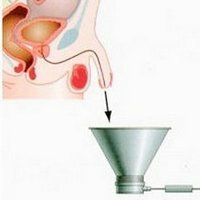
Uroflowmetry is a method for determining the flow rate of urine with independent urination
ultrasound of the bladder .It is carried out immediately after the end of urination. It allows to determine the presence of residual urine and its volume.
- Catheterization of the bladder ( see here).Can be performed instead of ultrasound, but only according to indications.
- Ultrasound examination of the pelvic organs ( prostate, etc.).
- Urgraphy - contrast radiography of the bladder.
- Cystoscopy .Minimal invasive examination of the bladder. It is called to reveal strictures, obstruction of the urinary canal with stones, etc.
- Uroflowmetry ( more details here).It is necessary to assess the intensity of urination.
In addition, the following can be done: analysis of prostate juice, spermogram, ultrasound of the kidneys. As a rule, these methods are sufficient to solve both of the above problems.
Therapy
To treat is necessary the initial disease, which caused incomplete emptying of the bladder. To stop the condition, a catheterization of the organ is required so that the bladder is released mechanically.
Treatment of the underlying cause is more frequent than surgery and involves partial excision of the prostate gland or its complete removal( with hyperplasia), taking anti-inflammatory drugs, antispasmodics, alpha-blockers( normalize the process of urination), antibacterial agents in proven prostatitis.
When it comes to strictures and obstruction of the urinary tract - not to do without surgery.
Tactics of therapy is determined only by a doctor, based on the primary factor of development of the condition. Often it is possible to be limited to medicamental therapy.
Complications of
The most likely and severe consequence of incomplete emptying of the bladder is an acute retention of urine. It is fraught with a rupture of the hollow organ with subsequent peritonitis.
The following complications of are also possible:
- Cystitis ( stagnant urine is an ideal nutrient medium for pathogenic flora).
- Renal failure ( more details).It does not appear immediately. To develop such a formidable complication, a prolonged course of the condition is required.
Incomplete emptying of the bladder is a dangerous condition, leading to serious consequences for health and even life. As soon as the patient notices a malfunction from the urinary system, one should immediately consult a doctor.
Recommended for viewing:

